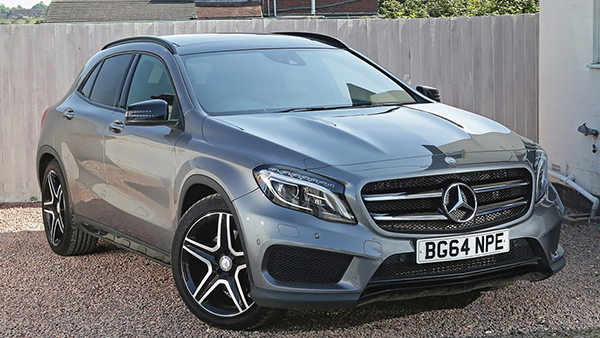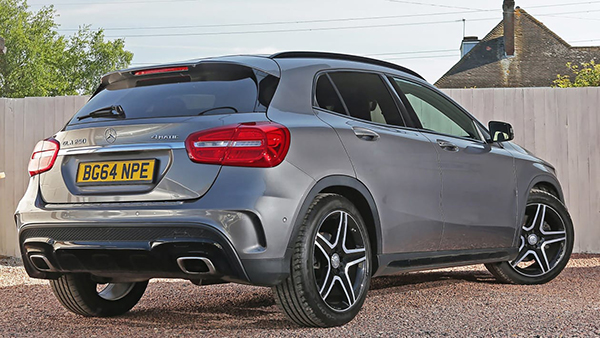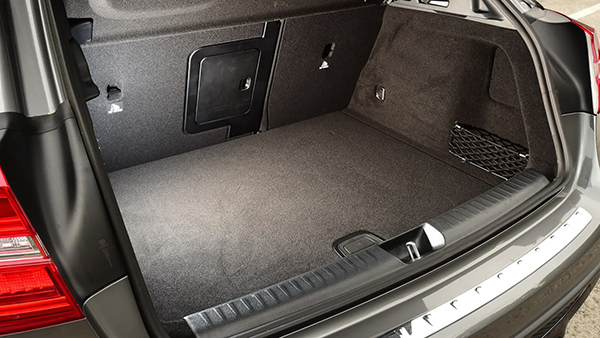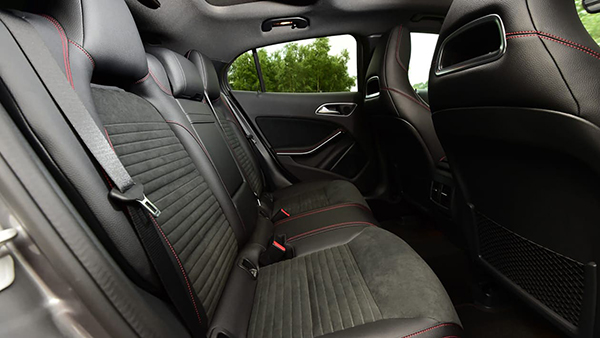It’s easy to see why the GLA has been such a success for Mercedes, because it has loads of showroom appeal. Most models have plenty of performance, a lot of standard equipment, and can cover long distances with ease, but the GLA has shortcomings, so you need to make sure that this is the right car for your needs. It’s not as practical as it should be and it doesn’t have the elevated seating position of some rivals. Prices are steep and while it’s fine to drive, the handling is inert. Still, the GLA should impress your neighbours.
Which one should I buy?
– Best Mercedes GLA for equipment: GLA 220 d 4MATIC WhiteArt Edition
– Best Mercedes GLA for fuel economy: GLA 200 d SE
– Best Mercedes GLA for driving fun: GLA 45 AMG

All GLA engines have four cylinders; the diesel should be more refined than it is, but it still makes the most sense because it offers plenty of muscle with the potential for 55mpg economy in the real world.
The manual gearbox is fine to use but the seven-speed automatic makes driving the GLA very relaxing, which is why it’s the transmission to go for; it’ll also make the car much easier to sell on. All GLAs are well equipped, but the options list is extensive, with lots of packs available, so establish the exact spec of any potential purchase. The key trim levels are SE, Sport and AMG Line; the GLA45 AMG gets its own equipment list. Other models include the WhiteArt Edition, introduced in 2017, plus the Urban Edition of 2018.
The GLA was facelifted in April 2017, so later cars make more sense when buying used. Revised styling to make the car appear chunkier, improved standard equipment and a revamped interior are the highlights. Short of finding a GLA with all of the option boxes ticked, the rare WhiteArt Edition is the plushest version you can buy. It’s highly recommended, but don’t pay over the odds.
What are the alternatives?
While the original BMW X1 wasn’t a very convincing car, the second-generation model that arrived in 2015 is a cracking crossover with efficient engines, excellent build quality and an inviting driving experience. Like the GLA, it’s no bargain.
The Audi Q3 is also very accomplished and while its driving experience and cabin design are rather clinical, it’s an easy car to recommend with its strong, refined engines and decent reliability record. A Mazda CX-3 is a less obvious alternative that’s great to drive, has a very high-quality feel and excellent engines. While its practicality is compromised, it’s very good value.
The original Range Rover Evoque is worth a look, too, now that prices have dropped.
Infiniti QX30 vs Mercedes GLA vs BMW X1
When is a Mercedes GLA not a Mercedes GLA? When it’s an Infiniti QX30. In 2016, the QX30 was the new crossover on the block, so we were keen to see if it could upstage its platform-sharing counterpart. Thanks to its lower price, longer list of standard kit and smarter cabin, the Infiniti finished above the Mercedes, but it couldn’t topple the BMW X1 from its perch.
Mercedes GLA vs Range Rover Evoque vs Audi Q3
Going back even further to 2014, the Mercedes GLA faced a formidable challenge when we pitched it against the Range Rover Evoque and Audi Q3. We criticised the GLA for feeling too much like a Mercedes A-Class hatchback, with a decent price and low running costs not enough for it to beat its rivals.
The Mercedes GLA was an expensive car to buy new. In many respects you were paying for the badge, especially when you consider that the Mk1 GLA was little more than an ‘A-Class on stilts’. Depreciation is less of a problem on a small Mercedes than it is on the larger saloons and SUVs, but a GLA with a raft of options is likely to lose more money in the first few years. Good news if you’re buying used.

Prices
You could spend as little as £14,000 on an early GLA, but this is likely to be an SE with the entry-level 200 d engine. Add another £5,000 for a facelifted version or £7,000 for a GLA45 AMG. Bank on spending at least £22,000 on a GLA still covered by its original manufacturer’s warranty. That said, with the new and improved GLA available for around £27,000, you might want to increase the budget, especially when the difference in the monthly repayments should be minimal.
Fuel economy and CO2 emissions
With a range of petrol engines being the only ones on offer after spring 2019, the Mercedes GLA has to give second best to its rivals for fuel efficiency. Under the latest WLTP test procedure, the GLA 180 manages up to 40.4mpg with the manual gearbox, while the auto-equipped version manages up to 39.2mpg. Go for the GLA 200, and these figures are 39.8mpg and 38.2mpg respectively. Move up to the 2.0-litre turbo petrol GLA 250, and it manages up to 35.8mpg, because it’s pegged back by its standard-fit 4MATIC four-wheel drive and auto gearbox.
The best-performing GLA models for fuel economy are the diesels. Whether you go for a manual or automatic gearbox, the front-wheel-drive Mercedes GLA 200 d is a cheap car to run, with a claimed 46.3mpg under the WLTP tests, while CO2 emissions stand at around 150g/km irrespective of whether you go for an automatic or manual.
The GLA 220 d features a more powerful version of the same engine, with 175bhp, but still shouldn’t break the bank when it comes to running costs. The official economy figure is quoted at 47.9mpg for the standard car and 47.1mpg for the AMG Line, although these figures are the older NEDC rates, and you’re more likely to achieve the claimed WLTP figures in the GLA 200 d in the real world.
Running costs
All GLAs need to be serviced every 12 months or 15,500 miles. Rates vary, so it’s worth shopping around to save money; you can get quotes from any official dealer at www.mymercedesservice.co.uk. Services alternate between minor and major, priced at around £250 and £425 respectively for diesels, while petrol-engined cars are about £240 and £340.
The big service is the fourth one, priced at £700-£750. The brake fluid needs to be replaced every two years (at £80), while the coolant needs to be renewed once every 15 years. All GLA engines are chain-driven so there’s no need for any replacement cam belts.
Insurance is another area in which the Mercedes is potentially going to be more expensive than its key competitors.
You’re looking at groups 22 and 23 for the GLA 180 and 200 models, while the GLA 250 sits in groups 28-30, depending on specification. However, entry-level versions of the Audi Q3 and BMW X1 start lower in the 20s and, with the exception of the flagship Audi RS Q3, neither rival exceeds insurance group 30, regardless of the model.
Mercedes has put a lot of work into improving its residual values, and small SUVs with premium badges are known for holding their money well, so the GLA will be less prone to depreciation than rivals.
As the Mercedes GLA SUV is based on the previous-generation A-Class hatchback, it carries over that car’s reasonable level of practicality – in the front of the cabin, at least. There are plenty of cubbyholes dotted around the interior and decent-sized door bins, while a large rear window and the elevated driving position improve visibility over the A-Class. The GLA is a five-seater only, as seven-seat layouts are reserved for larger SUVs in the Mercedes range, such as the GLS.
Even though it’s one of the longer cars in its class, the GLA is quite tight for space inside. That lower roofline impedes room slightly, particularly for passengers in the back.
Equally, the combination of small side windows and dark trim makes the cabin feel claustrophobic, while the front-seat runners are too close together, which reduces foot space for those in the rear.
Dimensions and cabin design
The GLA is quite a long car, measuring 4,417mm long by 1,804mm wide. That makes it longer than the Audi Q3 and the Range Rover Evoque, but slightly shorter than the BMW X1. However, the Mercedes’ low-slung stance – it’s only 1,494mm tall – and the fact that it’s based on a hatchback mean you don’t sit as high up as you do in any of its chief rivals, so the view out of the cabin isn’t as good.

Boot space
The 481-litre boot in the GLA is 61 litres bigger than those in the Audi Q3 and the Range Rover Evoque, although it’s a little shy of the 505 litres in the BMW X1. Fold the Mercedes’ rear seats down flat and you end up with 1,235 litres of space, which is less than the maximum boot capacity in its three main rivals, so that’s worth considering if you regularly transport big loads.
Equipment and technology
Unlike its tall, SUV-inspired rivals, the Mercedes GLA looks like a family hatchback on stilts – and that’s exactly what it is. While the large headlights, bold grille and curved roofline are reminiscent of the A-Class hatchback.
There are a few rugged elements to the GLA, such as the plastic body cladding and wheel arches, which mark it out as an SUV. The Urban Edition model comes with 18-inch 5-twin-spoke alloy wheels, LED high-performance headlights and Night package gloss black trim with aluminium roof rails, while AMG Line versions feature 19-inch alloys, AMG bodystyling and ARTICO man-made leather-trimmed sports seats.
Look out for the WhiteArt Edition, which was introduced as part of the 2017 facelift. In addition to everything that’s standard on the AMG Line version, it has 19-inch multi-spoke alloy wheels painted black with a matching colour matt foil, LED headlights with adaptive high-beam assist, Garmin navigation, parking assist, privacy glass, ambient lighting, heated front seats and a suite of cosmetic upgrades. With prices starting from £33,000, it was an expensive and exclusive edition, but one that’s worth seeking out on the used market.
By the end of the car’s life, the range was pared back to four trim levels: Urban Edition, SE, Sport and AMG Line. Many buyers opted for one of the equipment packs, so look out for them when considering a used GLA. The Executive pack cost £995 and came with active parking assist, Garmin sat-nav and heated front seats. The £1,695 Premium pack added ambient lighting, auto-dimming interior and exterior mirrors, electrically folding door mirrors and LED headlights with active high beam.
The Premium Plus pack cost a fiver short of £3,000 and featured keyless entry and start, electrically adjustable front seats with lumbar support and a panoramic glass sunroof.
The GLA’s interior follows on from that of the A-Class, as the dash has been inspired by the one in the company’s old SLS AMG supercar. It features racy-looking dials and a tablet-style display for the infotainment system, which features on other Mercedes models.
The large bezel design on this screen is now starting to look a little dated, but the interior is all solidly screwed together. Generally speaking, plenty of high-grade materials are used, although some of the plastics lower down on the dashboard look and feel a little low-rent.
The downside is that unlike in other compact SUVs, you don’t sit particularly high in the GLA due to its low-slung stance. The narrow windscreen and thick A-pillars mean occupants feel a little hemmed in, just as they do in the A-Class.
A larger eight-inch screen is standard across the range. Apple CarPlay and Android Auto come as standard, and both are easy to access via the system’s clearly laid out menus and neat graphics. A simplified version of the brand’s COMAND rotary controller is located on the transmission tunnel and it’s fairly simple to use.
Sat-nav is fitted to AMG Line variants, but all models feature a six-speaker audio system, Bluetooth and two USB ports.
Safety
In terms of safety, Mercedes has always set a high standard, because many of the features of its flagship luxury saloon, the S-Class, make their way down to the lesser models in the range.
All versions of the GLA come with Pre-Safe, which prepares you and the car for an impending accident; Attention Assist sounds a warning if the driver looks as though they’re about to nod off; and Collision Prevention Assist automatically applies the brakes if it detects an impending front-end collision.
Plenty of other hi-tech safety features were also available, although it did push up the price of the car if several options were fitted. The result is a full five-star Euro NCAP crash test rating, awarded in 2014.
As it rides 50mm higher, has fatter tyres and softer suspension than the previous-generation Mercedes A-Class hatchback on which it’s based, the GLA is the more comfortable car. There is a slight trade-off in terms of handling compared to the lower, firmer and 40kg lighter A-Class, but it’s a price well worth paying for the improved ride quality.

Engines
As of 2019, the GLA came with petrol power only, and the sole version of these that we’ve tried is the GLA 250. It uses a refined 2.0-litre petrol engine, and with 208bhp and standard-fit 4MATIC four-wheel drive, it can go from 0-62mph in 6.6 seconds.
Of the old diesels, the 134bhp GLA 200 d gives decent performance, with 0-62mph in 9.5 seconds. The 2.1-litre diesel is one of the larger units in the class, but it clatters noisily at idle, sending vibrations through the car’s floor. On the motorway, it settles down to a background hum, but becomes more intrusive as you work it harder.
Yet what the 200 d lacks in refinement, it makes up for with performance. With 134bhp on tap, the GLA is 30bhp more powerful than a Mazda CX-3 1.5D. When we tested a GLA 200 d, we recorded a 0-60mph time of 9.3 seconds. It also led the way during our in-gear tests, proving significantly faster than a CX-3 and Audi Q2 1.6 TDI from 30-50mph and 50-70mph.
However, on the road, the GLA never feels as fast as these figures suggest, because in default ECO mode, the gearbox shifts up early and throttle response is tardy. Sport mode is available, but this hangs on to the gears for longer, which results in much noisier progress. You can shift gears manually using the steering wheel-mounted paddles, but the gearshifts are ponderous for a twin-clutch unit.
The same 2.1-litre engine is also used in the 220 d, but here it has 175bhp so it’s noticeably quicker; just not quite as economical and certainly no more refined: anything other than gentle acceleration brings with it a coarse, loud rattle, and this doesn’t really improve once the engine has warmed up.
On the road
The GLA is far from a mess in the corners. While a BMW X1 is sharper from behind the wheel, the Mercedes gets close to rivals like the Audi Q3 for handling. However, both competitors still offer a more composed and refined ride.
What can make a difference here is the 4MATIC all-wheel-drive system. When connected to the seven-speed automatic gearbox (manual is not an option with 4MATIC) it can send up to 50 per cent of the engine’s power to the rear wheels for extra grip whenever they need it.
As with quite a few small SUVs, the Mercedes GLA suffers from a stiff low-speed ride. Things improve the faster you’re going, but the car is still prone to crashing over bumps and potholes, albeit not quite as badly as the A-Class hatchback.
Our other complaint with the driving experience is the unnatural way in which the variable power-assisted steering suddenly becomes heavier as you apply more lock in tighter turns. The inert and slow steering means it’s not the most involving car to drive on twisty roads, and it’s cumbersome around town and in tight car parks, but at least body control is quite good.
Despite the premium badge, buying a Mercedes GLA is no guarantee of quality. The fit, finish and materials are excellent, especially on the plush trim levels, but many owners have reported problems with their A-Class. With the two cars sharing many common parts, the GLA is likely to face the same issues.

Common used Mercedes GLA problems
Connector
If you can hear an annoying rattle from what sounds like the boot, it’s probably the wiring connector under the folding rear seat.
Key fob On cars with keyless go, the battery in the key fob tends to get exhausted quickly. You can fit a new CR2025 battery on a DIY basis.
Boot The boot latch can release the tailgate of its own accord. This is usually when the car has been left standing unused for a while.
Tyres There’s no provision for a spare wheel because the Mercedes GLA has run-flat tyres.
Recalls
There have been seven GLA recalls, each also affecting other Mercedes models. The first was in January 2015, because some GLAs could suffer from oil leaks; the next was in August 2015 due to potential airbag failures.
There were three campaigns in November 2015 for cars built between July and September that year because of possible engine failure. Fuel leaks were the reason for the sixth recall in January 2016. The last was in September 2016 due to possible dual-clutch transmission failure.
After a dip in quality in the nineties and early noughties, Mercedes once again produces some of the more reliable cars you can buy.
That being said, in our 2021 Driver Power satisfaction survey, Mercedes ranked 13th out of 29 brands in our manufacturer poll, which isn’t particularly indicative of a highly reliable marque. Indeed, Mercedes finished lower than premium rivals such as Jaguar, Lexus, Porsche and Volvo. However, owners reported more issues with cars built by Audi and BMW.
Reliability
Although the GLA didn’t get into the 2017 or 2018 Driver Power satisfaction surveys, the third-generation A-Class did. It finished 69th in 2017, beaten by the Audi Q3 (13th), Kia Sportage (12th) and Volvo XC60 (ninth). Owners rated the A-Class’s running costs and reliability, but not its engine, gearbox and safety kit. A year later it finished 56th out of 75 cars, with 11 per cent of owners finding a fault within the first year of owning their A-Class.
Mercedes-Benz GLA X156 Full Review
20/01/2022
No Comments
Mercedes-Benz | Mercedes-AMG
Click to rate this post
[Total: 1 Average: 5]